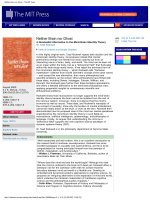the mit press governing global electronic networks international perspectives on policy and power dec 2008
Bạn đang xem bản rút gọn của tài liệu. Xem và tải ngay bản đầy đủ của tài liệu tại đây (5.31 MB, 681 trang )
Governing Global Electronic Networks
The Information Revolution and Global Politics
William J. Drake and Ernest J. Wilson III, series editors
/>The Information Revolution and Developing Countries
Ernest J. Wilson III, 2004
Human Rights in the Global Information Society
edited by Rikke Frank Jørgensen, 2006
Mobile Communication and Society: A Global Perspective
Manuel Castells, Mireia Ferna
´
ndez-Arde
`
vol, Jack Linchuan Qiu, and Araba Sey, 2007
Access Denied: The Practice and Policy of Global Internet Filtering
edited by Ronald J. Deibert, John G. Palfrey, Rafal Rohozinski, and Jonathan Zittrain, 2008
Governing Electronic Global Networks: International Perspectives on Policy and Power
edited by William J. Drake and Ernest J. Wilson III, 2008
Governing Global Electronic Networks
International Perspectives on Policy and Power
Edited by William J. Drake and Ernest J. Wilson III
The MIT Press
Cambridge, Massachusetts
London, England
( 2008 Massachusetts Institute of Technology
All rights reserved. No part of this book may be reproduced in any form by any electronic or
mechanical means (including photocopying, recording, or information storage and retrieval)
without permission in writing from the publisher.
For information about special quantity discounts, please e-mail
This book was set in Stone Serif and Stone Sans on 3B2 by Asco Typesetters, Hong Kong.
Printed and bound in the United States of America.
Library of Congress Cataloging-in-Publication Data
Governing global electronic networks : international perspectives on policy and power / edited by
William J. Drake and Ernest J. Wilson, III.
p. cm. — (Information revolution & global politics)
Includes bibliographical references and index.
ISBN 978-0-262-04251-2 (hbk. : alk. paper) — ISBN 978-0-262-54197-8 (pbk. : alk. paper)
1. Telecommunication policy. 2. Telecommunication—International cooperation. I. Drake,
William J. II. Wilson, Ernest J., III.
HE7645.G68 2008
384—dc22 2007037983
10987654321
Contents
Preface vii
Acknowledgments xv
1 Introduction: The Distributed Architecture of Network Global Governance 1
William J. Drake
I The Global Governance of Infrastructure 81
2 Sovereign Right and the Dynamics of Power in the ITU: Lessons in the Quest for
Inclusive Global Governance 83
Don MacLean
3 Balancing Equity and Efficiency Issues in Global Spectrum Management 127
Rob Frieden
4 The Peculiar Evolution of 3G Wireless Networks: Institutional Logic, Politics, and
Property Rights 149
Peter F. Cowhey, Jonathan D. Aronson, and John E. Richards
5 The GATS Agreement on Basic Telecommunications: A Developing Country
Perspective 187
Boutheina Guermazi
II The Global Governance of Networked Information, Communication, and
Commerce 231
6 Trade Barriers or Cultural Diversity? The Audiovisual Sector on Fire 233
Byung-il Choi
7 The Global Governance of Mass Media Content 275
Cees J. Hamelink
8 International Regulation of Internet Content: Possibilities and Limits 305
Peng Hwa Ang
9 Creating Conventions: Technology Policy and International Cooperation in
Criminal Matters 331
Ian Hosein
10 Privacy in the Digital Age: States, Private Actors, and Hybrid
Arrangements 375
Henry Farrell
11 Intellectual Property Rights, Capacity Building, and ‘‘Informational Development’’
in Developing Countries 401
Christopher May
III The Participation of Nondominant Stakeholders in Network Global
Governance 427
12 Louder Voices and the International Debate on Developing Country Participation
in ICT Decision Making 429
David Souter
13 The Ambiguities of Participation in the Global Governance of Electronic
Networks: Implications for South Africa and Lessons for Developing Countries 463
Tracy Cohen and Alison Gillwald
14 Spectators or Players? Participation in ICANN by the ‘‘Rest of the World’’ 507
Milton Mueller and Jisuk Woo
15 Multistakeholderism, Civil Society, and Global Diplomacy: The Case of the World
Summit on the Information Society 535
Wolfgang Kleinwa¨chter
16 Conclusion: Governance of Global Electronic Networks: The Contrasting Views of
Dominant and Nondominant Actors 583
Ernest J. Wilson III
Contributors 617
Index 623
vi Contents
Preface
The purpose of this book is to offer the reader nontraditional perspectives on the global
governance of global information and communication networks. Most work on this
subject concentrates on the largest, most powerful players in the world system.
Through their lens, hegemonic states and large multinational corporations are the cen-
ter of attention. In this volume we broaden the focus and consider the concerns of
those with less power and less influence—the nondominant actors, most notably the de-
veloping countries and civil society. In other words, this book views the global gover-
nance of networks more from the bottom up, and the outside in. Not surprisingly, the
view from the bottom and the outside is not the same as the view from the top down
and the inside out. Substantive priorities vary, as do interpretations of the value and
fairness of the institutionalized global processes that lead to substantive outcomes.
From the perspective of Washington, DC, and London, policy priorities adhere around
efficiency and market access, and institutions like the World Trade Organization
(WTO) and the World Intellectual Property Organization (WIPO), while the view from
Pretoria and Sao Paulo is more likely to emphasize digital divides and to seek leverage
points in the International Telecommunication Union (ITU) and international confer-
ences like the World Summit on Information and Society (WSIS).
Scholars and practitioners who seek to analyze this second perspective, like those in
this volume, are different in other ways too. They are more interested in explaining the
economic and political origins of the evolving rules of the game that structure the pro-
duction and distribution of communications in the global system, and how those rules
reinforce global power disparities while leaving some room for maneuver for the non-
dominant actors. This last point is critical. Our colleagues recognize that the global
governance of electronic networks greatly constrains nondominant actors, but it also
leaves them some freedom of action. Theirs is not an either/or dichotomy; nondomi-
nant actors are neither fully free nor hopelessly controlled.
This book grew from the editors’ frustration from attending conference after confer-
ence billed as addressing ‘‘global’’ information and communications technology (ICT)
issues at which speaker after speaker devoted comparatively little attention to the con-
ditions of the five billion people who live in developing and postcommunist societies.
The expert descriptions of the complex rules of the international communications
regimes, and their global impacts, rarely included the perspectives of nondominant
actors. Furthermore, their accounts of the ways that global networks were governed
concentrated mainly on matters of efficiency and Pareto optimality more than on mat-
ters of equity and distribution. By contrast, the contributors to this volume concentrate
as much on equity as on efficiency, and on the implications of governance arrange-
ments for nondominant actors and the global public interest.
As a complement to describing their structural positions within an inherently un-
equal system, all the authors also point out the existing spaces for maneuver and lever-
age that nondominant actors possess to improve their situation individually and
through collective action. We believe this offers a much more action-oriented and ulti-
mately optimistic view of power relations in the transition toward a knowledge society,
than simply another depressing catalogue of structural inequalities that submerge any
possibility for human agency.
A major goal of the book is to uncover the politics that lie beneath global rules and
regulations that may seem at first glance to be mainly technical. The authors search for
the political and institutional origins of the rules that govern global electronic net-
works, and the patterns of winners and losers those arrangements create. In this sense,
the volume is central to the MIT Press series of which it is a part, The Information Rev-
olution and Global Politics. It is certainly true that good analysts of the information
revolution must master the basics of the technology, and the ways they limit what is
possible. At the same time, good analysts must appreciate how some stakeholders
have more access than others to technology making and to rule making. In general,
privileged stakeholders design and enforce governance mechanisms that tend to favor
their material and ideological interests, and governance in the global (and national)
ICT sector is no exception. How information and communications resources are de-
ployed, how they should operate, and who pays for what are critical negotiation issues
in which actors bring to bear all the assets they can in order to gain the distributive
outcomes they seek. In the process, some clearly benefit more than others.
At its heart, global governance is about big issues like property rights, the definitions
of equity and efficiency, and who gets to write the rules of the game. We concentrate
on governance because at this moment in the transition toward knowledge societies, it
is a critically important but contested concept and process. In this period of extreme
turbulence about the ways basic norms, rules, and regulations guide human and insti-
tutional behaviors it is not surprising that all stakeholders are deeply concerned about
the character of governance.
Concerns about meanings and definitions and their links to power and agenda set-
ting came to the fore around the WSIS, held in Geneva in December 2003 and in Tunis
viii Preface
in November 2005. There and in the lengthy preparatory meetings there were debates
over how properly to frame the discussions of information and society. The excitement
and energy generated by the WSIS process helped to bump ICT global governance onto
a wider and more visible world stage. The editors of this volume attended both meet-
ings, and many of our authors played notable roles in the process. The WSIS debates
reinforced our perspective that one needs to devote much more attention to the ac-
tions, words, and interests of nondominant actors.
As indicated in the acknowledgments section of this volume, the diversity of par-
ticipants in the dialogues surrounding this project ensured we would have an anti-
technocratic take on the global governance of electronic networks. The initial
workshops involved participants with a variety of real-world practical experiences,
from grassroots organizers and corporate managers, to public officials and staff from
multilateral organizations. The thread of practicality they brought to our deliberations
provided a solid grounding in practice that stands in sharp contrast to other projects
that are either entirely academic or mainly practical.
Beyond our particular perspective—bottom up, outside in—the volume provides
careful explications of the main concepts of governance, and the levels at which gover-
nance is typically exercised, such as multilateral, minilateral, and private sector gover-
nance, each of which has its own inherent strengths and weaknesses for nondominant
actors. In addition, the volume presents the reader with rich empirical descriptions of
what is happening in the governance of a range of substantive topics, from third-
generation mobile networks to Internet domain names.
The volume is organized as follows. In the introduction (chapter 1), William Drake
sets the stage by providing a historical overview of ICT global governance and mapping
its contemporary architecture. He demonstrates that since 1850, we have progressed
through three distinct NetWorld Orders (NWOs), each of which has been characterized
by a particular blend of dominant technologies, ideas, interest configurations, and in-
stitutional arrangements. He concludes that despite the diversity of issues and institu-
tions involved, scholars and policy practitioners alike could usefully pursue holistic
analytical approaches to the field of ICT global governance.
We have divided the subsequent essays into three thematic parts. Part I deals with
the global governance of infrastructures, or the networks, services, applications, and re-
sources that make communication and information sharing possible. Don MacLean
(chapter 2) explicitly addresses matters of rule making, power, and the allocation of re-
sources that lie at the heart of governance. He takes up many of the thorny issues of
reform in an organization that was long central to governance but is of less importance
today—the ITU. MacLean shows that the ITU is beset by new challenges of radically
changing technologies and business models, and suggests new avenues of reform that
would, among other things, better accommodate the perspectives of nondominant
actors.
Preface ix
Rob Frieden (chapter 3) provides a guide to the ITU’s complex governance of interna-
tional radio frequency spectrum and geostationary satellite orbital slots. While quite
technical, when the technical layers are peeled away, Frieden shows that the gover-
nance framework tends to favor first movers over latecomers. He describes current pres-
sures on the framework and suggests ways that the interests of nondominant players
can be enhanced.
Looking at how self-interested actors jockey for political influence and market posi-
tion in a very complicated global arena is also the topic of Peter Cowhey, Jonathan
Aronson, and John Richards (chapter 4). The third generation of wireless networks rep-
resents a huge and hugely valuable territory on which the giants of international com-
merce battle for market shares, and powerful governments and regional bodies jostle to
influence the rules of the game and their interpretations. The authors describe how
this market works, the players that now dominate the field, and steps that nondomi-
nant actors can take to advance their interests.
Boutheina Guermazi (chapter 5) turns our attention to another key multilateral
body—the WTO. She assesses the WTO’s Agreement on Basic Telecommunications,
and the General Agreement on Trade in Services (GATS) of which it is part, from the
standpoint of developing countries’ interests. She concludes unequivocally that devel-
oping countries possess more leeway that they have exercised under these agreements,
but that they have suffered not only because of constraints imposed internationally,
but also because they have failed to organize themselves effectively and to pursue
sound bargaining strategies.
Part II of the book deals with the global governance of the information, communica-
tion, and commerce flowing over the networks. Byung-il Choi (chapter 6) bridges the
first two parts of the book by assessing the WTO’s GATS from another angle, namely its
treatment of international trade in audiovisual services. The author shows that the ne-
gotiations in the WTO have pitted proponents of a trade perspective (which holds that
audiovisual services should be subject to progressive trade liberalization like any other
sector) against proponents of a cultural perspective (which holds that they should not be
so governed due to their special cultural significance). Choi details the politics of au-
diovisual trade negotiations in the WTO and other settings (bilateral, regional, multi-
lateral) and argues that support for cultural industries should be pursued in a manner
that does not unduly distort international trade.
Cees Hamelink (chapter 7) surveys the global governance battles over traditional
mass media that have played out in multiple multilateral forums over the past century.
His treatment of the timeless tensions between governments’ interest in protecting
their populations from content they consider harmful, on the one hand, and the
(evolving) rights to communicate and seek information freely, on the other hand,
demonstrates how old issues reappear again and again even as the technology evolves.
On this contested terrain, Hamelink argues, none of the combatants are entirely pure:
x Preface
sovereign states have their own raisons d’etat for defining which content is harmful,
and international media corporations have their own profit imperatives for champion-
ing free speech.
Peng Hwa Ang (chapter 8) provides a parallel assessment of the tensions between
freedom of speech and state regulation in the context of the contemporary Internet en-
vironment. Insisting on the critical role of the state in the evolution of the Internet, his
chapter reflects the view of other intellectuals from Asia that collective responsibilities
in communications must be taken seriously, even as one respects individual rights. Sur-
veying various initiatives to establish rules on the circulation of content, Ang argues
that the inadequacies of industry self-regulation will lead governments to assert them-
selves more, perhaps including through international cooperation.
Ian Hosein (chapter 9) explores the increasingly central realm of security and cyber-
crime as the Group of Eight and the Council of Europe have addressed it. The author
finds fault with the approaches pursued in these bodies, which raise significant prob-
lems with respect to privacy and other key values. Moreover, their efforts have con-
stituted instances of policy laundering because they circumvent national democratic
discourses in favor of comparatively closed international decision-making processes.
Henry Farrell (chapter 10) considers governance mechanisms that are designed to
protect citizens’ privacy rights. He concentrates his attention on the relationship be-
tween the United States and the European Union (EU), which have pursued very differ-
ent approaches to the question, with the former preferring weaker international rules
than the latter. The author views power relations as central to the transatlantic accom-
modation that has been reached, and to the EU’s efforts to push third-party countries
toward higher levels of privacy protection.
Christopher May (chapter 11) examines the international politics of intellectual
property protection within the WTO and WIPO. Emphasizing power dynamics and
the distributive issues of winners and losers, he argues that the current trajectory to-
ward strict and expansive intellectual property rules has been driven by the industrial-
ized countries and their industries and is contrary to the needs of nondominant actors,
especially the developing countries. May covers a range of issues before outlining ways
in which nondominant actors can exploit the flexibilities provided by the relevant ar-
rangements to promote developmental and public interest objectives.
The third and final part of the book deals more intensively with the problems non-
dominant actors confront in seeking to participate in ICT global governance processes.
David Souter (chapter 12) writes from the perspective of one of the authors of the
pathbreaking international report Louder Voices (2002). Souter assesses the continuing
relevance of the report’s main findings regarding the domestic and international insti-
tutional issues that can limit the effectiveness of developing countries’ participation.
In general, he argues that the most pressing problems concern domestic constraints
and capacity building, and that sophisticated leadership will be needed if developing
Preface xi
countries are to participate and defend their interests effectively in international
negotiations.
Tracy Cohen and Alison Gillwald (chapter 13) demonstrate how the sort of issues
highlighted by Souter play out in a specific case—the highly politically charged con-
text of post-apartheid South Africa. The authors present a fine-grained analysis of the
country’s participation in the ITU and the WTO, demonstrating that international
power dynamics and institutional factors can interact with domestic conditions to
limit developing countries’ influence in governance processes. They argue that these
institutions do provide developing countries with some flexibility, but that global
governance reform is needed nevertheless.
The same themes of power, institutions, and participation emerge with considerable
clarity in the contribution by Milton Mueller and Jisuk Woo (chapter 14). The authors
examine South Korea’s involvement in the Internet Corporation for Assigned Names
and Numbers (ICANN). They show that Western governments (most notably the
United States) and transnational firms (such as intellectual property interests) have
dominated ICANN at the expense of the developing and transitional economies, which
the authors dub the ‘‘rest of the world.’’ Mueller and Woo propose a series of changes
to ICANN in order to enhance the rest of the world’s effectiveness in that crucial inter-
national body.
Wolfgang Kleinwa
¨
chter (chapter 15) turns our attention from developing countries
to another set of nondominant actors—global civil society. He traces the evolution of
civil society participation in the WSIS process and the development of ‘‘multistake-
holderism’’ as a new principle that may come to inform more of ICT global gover-
nance. However, he cautions that to make this scenario viable, civil society actors will
have to become better organized and more adept at securing governmental recognition
of their legitimacy and importance as partners.
In the volume’s conclusion (chapter 16), I synthesize some of this project’s main les-
sons by posing and answering four guiding questions: Is there a Washington consensus
separate from the preferences of nondominant actors? Are the current ICT governance
mechanisms working well or are they broken? What is the impact of the current GGEN
arrangements on nondominant actors? What can scholars and researchers do to help
practitioners in the field of ICTs?
We believe the perspective of those who stand on the outside looking in, and at the
bottom looking up, is an important corrective to some of the work on ICT global gov-
ernance. Not every chapter in this book analyzes this overarching theme to the same
extent, or even from the same angle. But the authors’ analyses help to situate the ‘‘out-
side-in’’ discussion within a broader range of substantive and institutional issues not
typically incorporated into discussions of governance. The reader is invited to reflect
on how these contributions help enrich our understanding not only of those on the
outside and at the bottom, but also how these insights may change our understanding
xii Preface
of the behaviors of the privileged nations who sit inside, and at the top, of the gover-
nance system. Much of the scholarly work on international regimes, for example, starts
with the assumption that global governance structures are positive sum arrangements
for rich and poor alike. Our authors call this assumption into question.
Not every volume can cover every topic. Some issues we did not include in this vol-
ume still deserve more critical attention. For example, scholars should pay more atten-
tion to the weight of private sector actors in global governance, both in their efforts to
influence government bodies, and also in their own firm-level commercial and long-
term strategic choices. Still, as this book’s authors demonstrate, there are more than
enough important issues to engage scholars for years to come in the changing dynam-
ics of the governance of global electronic networks.
Ernest J. Wilson III
Preface xiii
Acknowledgments
This volume is the product of an extended process of dialogue and collaboration. In
November 2002, we organized a pair of workshops at the Central European University
in Budapest, Hungary, under the aegis of the Information Technology and Inter-
national Cooperation (ITIC) Program of the Social Science Research Council (SSRC).
These initial brainstorming workshops explored public policy and research issues
related to the global governance of the ICTs involved in electronic networking. Partic-
ipating in the workshops were thirty-three experts from nineteen countries drawn
from international organizations, governments, businesses, civil society organizations,
academia, and research institutions. They included Carlos Afonso, Casey Anderson,
Byung-il Choi, Tracy Cohen, Darius Cuplinskas, William Drake, Anriette Esterhuysen,
Henry Farrell, Laura Forlano, Francois Fortier, Vera Franz, Robert Frieden, Victor Gao,
Alison Gillwald, Boutheina Guermazi, Ian Hosein, Tim Kelly, Meelis Kitsing, Andrey
Korotkov, Nino Kuntseva-Gabashvili, Robert Latham, Don MacLean, Kaz Maekawa,
Tattu Mambetalieva, Marta Mateo, Christopher May, Milton Mueller, Saskia Sassen,
Sidharth Sinha, Motohiro Tsuchiya, Ernest Wilson, Jisuk Woo, and Robert Valantin.
Twelve of the scholars in attendance provided initial concept memos on the dynamics
of global governance in some key ICT issue areas, most of which subsequently devel-
oped into book chapters. Additional scholars were recruited at different points in time
in order to expand our coverage of newly emerging issues, and dialogue among project
participants continued both online and in various meetings held under ITIC and other
auspices. The evolutionary assembling of authors and topics, coupled with rapid
change in the subject matter being addressed, resulted in some discrepancies in the
chronological endpoints of the draft chapters; this was particularly true with respect
to the United Nations’ 2002–2005 World Summit on the Information Society (WSIS)
negotiations, in which some of the authors were quite involved. As such, all but one
of the chapters were revised and updated in 2006–2007.
In addition to the authors and other project participants, we would like to thank the
following people. Craig Calhoun, the president of the SSRC, and Saskia Sassen, who
served as chair of the ITIC Steering Committee, supported the project from the outset,
and created a facilitative intellectual and institutional environment. Robert Latham
served as director of the ITIC Program and played a key role in developing the project
concept in collaboration with the editors. Laura Forlano served as project manager of
the ITIC Program and provided important intellectual input and logistical support.
Becky Lentz, a program officer in the Knowledge, Creativity and Freedom Program at
the Ford Foundation, provided financial support for the ITIC Program and, by exten-
sion, the initial workshops in Budapest. Finally, Darius Cuplinskas, director of the
Information Program at the Open Society Foundation, provided additional financial
and logistical support for the meetings in Budapest. Our heartfelt thanks to them all.
xvi Acknowledgments
1 Introduction: The Distributed Architecture of Network Global
Governance
William J. Drake
The burgeoning use of global electronic networks and related information and commu-
nication technologies (ICT) is widely recognized to be one of the defining features of
contemporary world affairs. Electronic networks underlie and enable the relational net-
works linking individuals and organizations that are catalyzing economic, political,
and sociocultural change on a worldwide basis. So deep and widespread is the change
in key domains of social organization that it is difficult to disagree with Manuel
Castells’s observation that, ‘‘Networks constitute the new social morphology of our
societies, and diffusion of networking logic substantially modifies the operation and
outcomes in processes of production, experience, power, and culture.’’
1
Among other
things, as Robert Latham and Saskia Sassen point out, networks are giving rise to signif-
icant new digital formations, ‘‘communication and information structures largely con-
stituted in electronic space. Examples are electronic markets, Internet-based large-scale
conversations, knowledge spaces arising out of networks of nongovernmental organi-
zations (NGOs), and early conflict warning systems, among others. Such structures re-
sult from various mixes of computer-centered technologies and the broad range of
social contexts that provide the utility logics, substantive rationalities, and cultural
meanings for much of what happens in these electronic spaces.’’
2
As the Internet and
digital convergence continue to evolve and computation becomes increasingly ubiqui-
tous in the years ahead, the centrality of electronic networks at the national and global
levels and the creation of such new social forms will only increase.
Of course, electronic networks do not simply appear holus-bolus or have some
intrinsic, transcendent properties. Instead, their capabilities, utilization, and impact
result from social shaping processes that reflect human agents’ objectives and inter-
actions. Governance, or social steering, is a configurative force in this context, and it is
exercised at multiple levels, from the intraorganizational up to local, national, regional,
and global spheres. This book is concerned with the last of these levels—the global
governance, particularly by intergovernmental institutions, of networks and related
ICT.
3
The electronic networks of interest here generally are planetary in scope, but
they may be less geographically extensive and still have significant and configurative
implications for both global networking and global policy. When electronic networks
and the transactions they facilitate have crossed national borders, governments and
the private sector usually have sought to establish shared rule systems, procedures,
and programs that would guide the behavior of the actors involved.
The global governance of electronic networks has a very long pedigree. Indeed, inter-
national telecommunications was the first field in which nation-states established
a multilateral intergovernmental organization—the International Telegraph Union,
now the International Telecommunication Union (ITU), formed in 1865. Over the
nearly century and a half to follow, global governance has evolved through three dis-
tinct phases (described later in this chapter), each of which has been characterized by a
particular blend of dominant technologies, ideas, interest configurations, and institu-
tional arrangements. In the third, current phase, we have seen a proliferation in the
number and forms of governance mechanisms, as well as a deepening shift in social
purpose away from restrictive state control and regulation and toward promoting
globalized markets, private sector control, and security. Global governance mecha-
nisms today include not only arrangements negotiated by governments, the private
sector, and multistakeholder collaborations, but also arrangements imposed by power-
ful governments and companies possessing monopoly or oligopoly power in particular
global markets. In addition, the coordinated convergence of national policies and cor-
porate practices is becoming a significant source of global ordering, even if it is not
codified in collective agreements. This book could not explore these latter forms of
global governance, but they are important parts of the contemporary mix nonetheless.
The transformations in governance underway today have been driven by a number
of factors. The most important of these has been the material and ideational power of
the major industrialized countries, most notably the United States, and of transna-
tional corporations (TNCs). In contrast, nondominant actors—such as the developing
countries, small- and medium-sized enterprises, and civil society organizations (CSOs)
—generally have found themselves to be in the positions of governance takers, rather
than governance makers. To be sure, in some cases these actors have influenced gover-
nance decision making to varying degrees or have benefited from its results. But in
many others, the current trajectory has been adverse to their interests, at least as they
define them.
As the last point may suggest, the stakes in this arena are high. How and to whose
benefit global governance is configured raises significant questions from a global public
interest perspective. For example, many observers have heralded the Internet age as an
era of almost unlimited possibilities for human empowerment and the weakening or
dissolution of restrictive power centers. Yochai Benkler captures this spirit when he
suggests,
2 William J. Drake
What characterizes the networked information economy is that decentralized individual action—
specifically, new and important cooperative and coordinate action carried out through radically
distributed, nonmarket mechanisms that do not depend on proprietary strategies—plays a much
greater role than it did, or could have, in the industrial information economy. . . . The declining
price of computation, communication, and storage have, as a practical matter, placed the material
means of information and cultural production in the hands of a significant fraction of the world’s
population—on the order of a billion people around the globe.
4
But in practice, how easily and to what ends that billion people can utilize ICT, whether
their empowerment will be offset by other dynamics, and where this leaves the billions
more who lack the same opportunities, will all be directly affected by the character of
global governance and related patterns of social ordering.
The high stakes involved were made particularly clear in the course of the United
Nations’ 2002–2005 World Summit on the Information Society (WSIS) process. That
process involved thousands of representatives from stakeholder groupings, including a
number of the authors in this volume. It comprised major summits held at Geneva in
December 2003 and at Tunis in November 2005, and a series of very lengthy prepara-
tory negotiations and regional conferences. The WSIS tackled a broad range of issues
pertaining to the global information society and adopted four instruments containing
general principles and norms that, while nonbinding, impacted the global policy dis-
course on ICT and the programmatic work of many organizations going forward.
5
In
the course of the process, global Internet governance—what it is, and who should con-
trol it—became a key point of contention. Had the summit resulted in the sort of sig-
nificant changes to Internet governance that were being proposed by many developing
and transitional countries, the consequences for the future evolution of the Internet
and the global information society more generally would have been profound indeed.
With these considerations in mind, this volume places at center stage the questions
of power and social purpose in network or ICT global governance. Of course, explain-
ing outcomes requires due attention to the interests and negotiating behavior of the
dominant players that shape them—what might be called governance ‘‘from above.’’
But where possible, the contributors also try to emphasize how global governance
looks ‘‘from below,’’ most notably from the perspectives of the developing countries
and civil society advocates of public interest objectives. Moreover, it should be noted
that our intended audiences in this project included not only scholars, but also policy
practitioners working in international organizations, governments, the private sector,
and civil society. The cases included herein were selected because they are practically
important, rather than in accordance with a particular scholarly methodology. Given
this orientation, after describing the governance mechanisms in question and assessing
the power dynamics and issues in play, each of the chapters concludes with a set of
recommendations for action by either particular stakeholder groupings or the interna-
tional community as a whole. Some are broadly framed principles, while others address
Introduction 3
specific problems currently under discussion in international forums. Taken together,
they may be seen as constituting a starting point for the development of a holistic
global public interest agenda.
To set the stage for the discussions to follow, this chapter takes a somewhat unor-
thodox path for an introduction to an edited volume. As the authors do not employ a
singular theoretical approach that needs to be introduced and the thrust of their chap-
ters is previewed in Ernest Wilson’s preface, I will instead provide an overview of gov-
ernance mechanisms that is intended to complement and contextualize the authors’
more detailed treatments. Accordingly, the first section addresses the definitional ques-
tion of what we mean by global governance, particularly with respect to networks and
related ICT. The second section highlights the main stages in the evolution of network
global governance from 1850 to the present. The third section provides a survey of
some of the major global governance mechanisms pertaining to network infrastruc-
ture, both physical and logical, as well as related transport services. These include the
frameworks for telecommunications regulation and standardization, radio frequency
spectrum management, satellite systems and services, trade in telecommunications
services, trade in ICT goods, and Internet identifiers. The fourth section provides an
overview of governance mechanisms pertaining to the information, communication,
and commerce conveyed over electronic networks. These include the frameworks for
information flow and content, trade in content services, intellectual property, elec-
tronic commerce, cybersecurity, and privacy protection. Finally, the concluding sec-
tion offers some brief thoughts about the potential value of viewing this range of
mechanisms from an integrative, holistic analytical perspective.
The Nature of ICT Global Governance
The term global governance gained widespread currency in the discourses of inter-
national relations scholars and practitioners during the 1990s. The term fit well within
a zeitgeist shaped by the end of the Cold War, globalization, the Internet stage of the
information revolution, the growth of private corporate authority, the mobilization of
CSOs, and the alleged erosion of territorial sovereignty as the primary organizing prin-
ciple of world politics. These and related trends seemed to increase the demand for
global-ordering mechanisms created through not only traditional forms of intergov-
ernmental cooperation, but also industry self-governance, multistakeholder partner-
ships, and transgovernmental relations. The global governance rubric seemed to
encompass the new issues and collective responses that were emerging, and it had the
added benefit of being nicely alliterative and hence catchy and marketable as well.
In consequence, global governance became the raison d’e
ˆ
tre for a cottage industry of
scholarly researchers and policy analysts. For example, in 1995, a high-level Commis-
sion on Global Governance released a wide-ranging and influential report calling for
4 William J. Drake
new initiatives to manage global problems and reform the United Nations. In the same
year, the Academic Council on the United Nations System (ACUNS) and the United
Nations University launched a new scholarly journal, Global Governance: A Review of
Multilateralism and International Organizations. In parallel, academic institutions and
think tanks established a number of research programs on the subject, and many inter-
national organizations and CSOs adopted the term as an organizing construct for their
work. Interestingly, and exemplified in particular by the ACUNS journal, global gover-
nance has served as a vehicle for policy-oriented dialogue between scholars and policy
practitioners from all sectors. Indeed, one could argue that the concept has become so
widely institutionalized across professional environments and incorporated into so
many actors’ thought and work that it has become for them a social episteme, or ‘‘the
background intersubjective knowledge—collective understandings and discourse—
that adopt the form of human dispositions and practices that human beings use to
make sense of the world.’’
6
But what do we really mean by global governance? Given the passage of time since
its rise in the lexicon and the extent to which it has been internalized by analysts and
practitioners, one might expect there to be a widely agreed on understanding of the
term. Nevertheless, no standard meaning is evident in the relevant academic and
policy literatures and discourses. A particularly unhelpful source of dissensus is the ten-
dency of some people to use the term in a highly normative manner, and to conflate it
with particular instanciations of governance they do or do not favor. For example,
there are liberal internationalists who equate the term with ‘‘good governance’’ and
efforts by the international community to advance worthy goals like peace, develop-
ment, and environmental stewardship; conservatives who equate it with unduly politi-
cized and bureaucratic intergovernmentalism or even ominous schemes to establish
world government; and progressives who equate it with neoliberal economics, corpo-
rate control, and the dominance of the rich over the poor. In reality, of course, gover-
nance can be done well or poorly and can serve any number of social purposes.
Even among the scholars and practitioners who construe the term in an appropri-
ately value-neutral manner, there are differences, sometimes substantial, in its interpre-
tation. To note some examples, governance and global governance have been defined
as follows:
This study operationalizes the amorphous term governance by defining it as the ability of a govern-
ment to exercise public policy.
7
Governance is characterized by decisions issued by one actor that a second is expected to obey.
8
There is good reason to use the global governance concept in reference to the salience of globally
oriented epistemic elites and authorities.
9
Global governance is governing, without sovereign authority, relationships that transcend na-
tional frontiers. Global governance is doing internationally what governments do at home.
10
Introduction 5
One of the best ways to explore global governance, what world government we actually have had, is
to consider the history of world organizations, those intergovernmental and quasi-governmental
global agencies that have (nominally) been open to any independent state (even though all states
may not have joined.
11
Governance refers to all the ways in which groups of people collectively make choices.
12
[The authors] define ‘‘global governance’’ as collective efforts to identify, understand, or address
worldwide problems that go beyond the capacity of individual states to solve.
13
Governance, at whatever level of social organization it may take place, refers to conducting the
public’s business: to the constellation of authoritative rules, institutions and practices by means
of which any collectivity manages its affairs.
14
At the most general level, governance involves the establishment and operation of social institu-
tions (in the sense of rules of the game that serve to define social practices, assign roles, and guide
interactions among the occupants of these roles) capable of resolving conflicts, facilitating cooper-
ation, or, more generally, alleviating the collective-action problems in a world of interdependent
actors.
15
The Centre understands global governance not as government but as a minimum framework of
principles, rules and laws necessary to tackle global problems, which are upheld by a diverse set
of institutions, including both international organisations and national governments.
16
Governance is the sum of the many ways individuals and institutions, public and private, manage
their common affairs. It is a continuing process through which conflicting or diverse interests may
be accommodated and cooperative action may be taken. It includes formal institutions and
regimes empowered to enforce compliance, as well as informal arrangements that people and
institutions either have agreed to or perceive to be in their interest.
17
By global governance is meant not only the formal institutions and organizations through which
the rules and norms governing world order are (or are not) made and sustained—the institutions
of state, intergovernmental cooperation and so on—but also those organizations and pressure
groups—from [multinational corporations], transnational social movements to the plethora of
non-governmental organizations—which pursue goals and objectives which have a bearing on
transnational rule and authority systems.
18
As a point of departure, governance is here conceived at a very abstract level as spheres of au-
thority (SOAs) at all levels of human activity—from the household to the demanding public to
the international organization—that amount to systems of rule in which goals are pursued
through the exercise of control . . . Governance, in other words, encompasses the activities of gov-
ernments, but it also includes any actors who resort to command mechanisms to make demands,
frame goals, issue directives, and pursue policies.
19
To meet the requirements of a broad conception, governance is here regarded as sustained by rule
systems that serve as steering mechanisms through which leaders and collectivities frame and
move toward their goals. In the state-centric world some of the rule systems are resided over by
states and their governments, while international institutions and regimes maintain others. In
6 William J. Drake
the multi-centric world numerous steering mechanisms are to be found in NGOs, and still others
consist of informal SOAs that may never develop formal structures.
20
By governance, we mean the processes and institutions, both formal and informal, that guide and
restrain the collective activities of a group. Governance need not necessarily be conducted exclu-
sively by governments and the international organizations to which they delegate authority.
Private firms, associations of firms, nongovernmental organizations (NGOs), and associations of
NGOs all engage in it, often in association with governmental bodies, to create governance; some-
times without governmental authority.
21
Analytically, we define global governance by three criteria . . . First, we see global governance as
characterized by the increasing participation of actors other than states, ranging from private
actors such as multinational corporations and (networks of) scientists and environmentalists to
intergovernmental organizations (‘‘multiactor governance’’) . . . Second, we see global governance
as marked by new mechanisms of organization such as public-private and private-private part-
nerships, alongside the traditional system of legal treaties negotiated by states . . . Third, we see
global governance as characterized by different layers and clusters of rule-making and rule-
implementation, both vertically between supranational, international, national and subnational
layers of authority (‘‘multilevel governance’’) and horizontally between different parallel rule-
making systems.
22
International regimes . . . are institutional arrangements whose members are states and whose
operations center on issues arising in international society . . . Transnational regimes, by contrast,
are institutional arrangements whose members are nonstate actors and whose operations are per-
tinent to issues that arise in global civil society I use the phrase global governance . . . to refer to
the combined efforts of international and transnational regimes.
23
In the broadest possible definition, ‘‘governance’’ relates to any form of creating or maintaining
political order and providing common goods for a given political community on whatever level
. . . ‘‘new modes of global governance’’ would refer to those institutional arrangements beyond the
nation-state that are characterized by two features: the inclusion of non-state actors, such as firms,
private interest groups, or nongovernmental organizations (NGOs) in governance arrangements
(actor dimension); [and] an emphasis on non-hierarchical modes of steering (steering modes).
24
These eighteen formulations by leading scholars and practitioners obviously raise
numerous questions. For present purposes I will highlight just three issues that bear
directly on the treatment of global governance in this chapter. First, a few of these
definitions emphasize social actors and their characteristics and interrelationships,
while most of the others emphasize social institutions and rule systems. As is often
noted in the literature, the etymology of the word govern derives from the Greek words
‘‘kybenan’’ and ‘‘kybernetes,’’ meaning ‘‘to steer’’ and ‘‘pilot of helmsman,’’ respec-
tively. Actor-centric understandings derived from the latter term were long the norm
in ordinary language; governance was equated with the exercise of control by an au-
thoritative actor, particularly a government. But from the 1990s onward there has
been a general evolution away from this approach, and rightfully so.
Introduction 7
Governance is best defined in terms of the act of governing—establishing prescrip-
tions and proscriptions that steer or guide—rather than the particular governors that
engage in the act. Given that governance exists in many social settings and can be
exercised by a variety of actors, this avoids having to load into the definition variable
listings of the actors and their characteristics and relationships in accordance with dif-
ferent analysts’ preferences. Moreover, while actor-centric definitions tend to explicitly
or implicitly invoke hierarchical authority relationships, it is entirely possible to have
rule systems that instead derive from symmetric, horizontal relationships. Consequen-
tial rules must be authoritative in the sense of being credible and of widely recognized
applicability, but they need not be vertically imposed or backed by any particular
actor’s power or authority. In short, who governs is a separate matter from what
it means to govern, and maintaining this separation also comports with normal lan-
guage usage; if we do not define verb/noun pairings like dominate/dominance, resist/
resistance, or tolerate/tolerance in terms of who is involved or their attributes, why
should we do so with govern/governance?
Second, and conversely, most of the definitions emphasize process and the role of
institutions, such as decision-making procedures and substantive rule systems, in steer-
ing social action. This approach is preferable, but some of these definitions add ele-
ments that seem extraneous or based on particular instanciations that reduce their
generalizability to other cases. For example, global governance need not by definition
provide common goods; be nonhierarchical, necessary to tackle global problems, or
concerned only with truly worldwide problems that are beyond the capacity of indi-
vidual states to solve; include particular organizational forms like public-private part-
nerships; or be capable of accommodating diverse interests, resolving conflicts and
collective-action problems, and enforcing compliance. In many cases, these conditions
may be absent. Nor does it seem right to apply the term to any and all the ways in
which groups of people make choices; to mere efforts to identify and understand prob-
lems; or to the activities of pressure groups seeking to influence governance decision
making.
Third, many of the definitions emphasizing process and the role of institutions seem
to equate the term to collective decision making. However, it is also possible for a dom-
inant actor to unilaterally establish global governance mechanisms. Global ordering
may result from such actors using power to impose rules, or it may simply arise post
hoc as other actors opt to align their behavior. Either way, what matters in such cases
is that governance mechanisms are collectively recognized to be applicable to rather
than negotiated by a globally significant range of actors.
These comments suggest that a definition of global governance should be action-
oriented rather than actor-oriented, concerned with steering mechanisms or institu-
tions, generalizable across cases, and reasonably concise. As such, for the purposes of
this chapter, I suggest the following working definition: global governance is the develop-
8 William J. Drake









